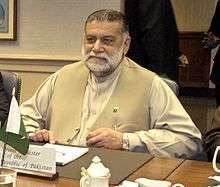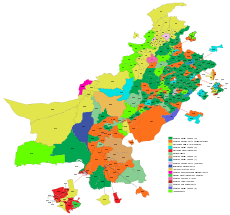Pakistani general election, 2002
| | |||||||||||||||||||||||||||||||||||||||||||||||||||||||||||||||||||||||||||||||||||||||||||||||||||||||||||||||||||||||||||||||
| |||||||||||||||||||||||||||||||||||||||||||||||||||||||||||||||||||||||||||||||||||||||||||||||||||||||||||||||||||||||||||||||
| |||||||||||||||||||||||||||||||||||||||||||||||||||||||||||||||||||||||||||||||||||||||||||||||||||||||||||||||||||||||||||||||
|
| |||||||||||||||||||||||||||||||||||||||||||||||||||||||||||||||||||||||||||||||||||||||||||||||||||||||||||||||||||||||||||||||
| Results of elections showing political parties. | |||||||||||||||||||||||||||||||||||||||||||||||||||||||||||||||||||||||||||||||||||||||||||||||||||||||||||||||||||||||||||||||
| |||||||||||||||||||||||||||||||||||||||||||||||||||||||||||||||||||||||||||||||||||||||||||||||||||||||||||||||||||||||||||||||
The Pakistan General elections of 2002 were held in Pakistan on 10 October 2002 to elect the National Assembly of Pakistan and the provincial assemblies. The elections were held under the watchful scrutiny of the military government of General Pervez Musharraf.[1] This elections features the multiparty democracy and, Pakistan again returned to democracy.
Around 70 parties took participation in the elections for the office of Prime minister Secretariat, only six party managed significant popular support for the prime minister candidacy. The elections were broadcast live by the private and government-controlled media, and were general free and fair elections. With the conclusion of these elections, Pakistan returned to democracy and the two-party system was evolved into multi-party system.
Parties and candidates
More than 70 parties, contested the election, the main parties were the Peoples Party Parliamentarians, Pakistan Muslim League-Nawaz Group, Muttahida Quami Movement (MQM), Pakistan Muslim League-Quaid-i-Azam also called the "King's Party" for its unconditional support to the government, and the Muttahida Majlis-i-Amal (MMA), alliance of six religious political parties. Other known parties contesting at the national level included the six-party National Alliance led by former Former President Farooq Ahmad Lagari, Imran Khan's Pakistan Tehrik-i-Insaaf and Tahir-ul-Qadri's Pakistan Awami Tehrik.[1]
Results
Summary of the October 2002 National Assembly elections
| % of popular vote | Seats | ||
|---|---|---|---|
| Pakistan Muslim League (Quaid-e-Azam) | 25.7 | 126 | |
| Pakistan Peoples Party Parliamentarians | 25.8 | 81 | |
Muttahida Majlis-e-Amal Pakistan
|
11.3 | 63 | |
| Pakistan Muslim League (Nawaz) | 9.4 | 19 | |
| Muttahida Qaumi Movement | 3.1 | 17 | |
| National Alliance | 4.6 | 16 | |
| Pakistan Muslim League (Functional) | 1.1 | 5 | |
| Pakistan Muslim League (Junejo) | 0.7 | 3 | |
| Pakistan Peoples Party (Sherpao) | 0.3 | 2 | |
| Pakistan Tehreek-e-Insaf | 0.8 | 1 | |
| Pakistan Awami Tehreek (Pakistan People's Movement) | 0.7 | 1 | |
| Jamhoori Wattan Party (Republican National Party) | 0.3 | 1 | |
| Pakistan Muslim League (Zia-ul-Haq Shaheed) | 0.3 | 1 | |
| Pakistan Democratic Party | 0.3 | 1 | |
| Balochistan National Party | 0.2 | 1 | |
| Awami National Party | 1.0 | - | |
| Pakhtun-khwa Milli Awami Party | - | 1 | |
| Independents | - | 3 | |
| Non-partisans (most joined one of the above parties) | 14.1 | 21* | |
| Female elected members (included in party seats above) | . | 60* | |
| Minorities (included in party seats above) | . | 10* | |
| Total (turnout 41.8%) | 342 | ||
| Source: Pakistan Electoral Commission & CIA Factbook
Not included in total. Except for three independents, most of these are included in the party-seat numbers | |||




